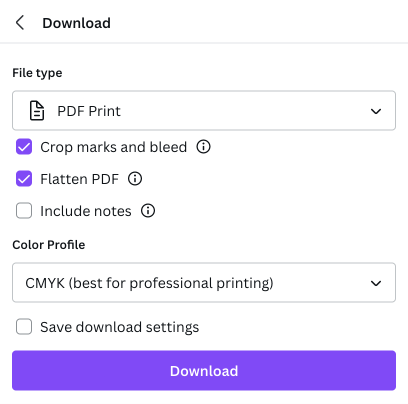Quotes take about 24 hrs. Let us know if you need it sooner. After you place your order by replying to your quote, we order your paper and you will receive a PDF proof within a day. Offset jobs take 3-5 days after you approve your proof. Digital jobs take less time. Let us know what you need!
You can upload your artwork here.
- We want PDFs or native (original) files
- If you send as a JPG/TIF/PNG the resolution should be at least 300dpi
- If you send native files please also include fonts and links in a .zip folder
We accept InDesign, Illustrator, Photoshop, PDF and EPS files. Images such as JPG, TIF, PNG can be submitted as print files as long as they are 300 ppi or higher and include .125 bleed. For more information about preparing files to submit to us, please see our tips and tricks section.
To send us files from Canva, download your file using the PDF Print setting. Check the boxes marked “Crop marks and bleed” and “Flatten PDF,” and choose CMYK for the color profile. RGB is OK if you don’t have a Pro account; just know that the color will look a little different once it’s converted to CMYK.
First you will receive a proof in PDF format via email. In order to review the proof, you will need Adobe Acrobat Reader, which is availabe here. After that, we output a hardcopy proof. You are welcome to see this proof. If your work is 4-color process, your proof will be color correct. Once we receive your final approval in writing (email is acceptable), we go into production. You are welcome to Press Check your job or see a first-off for digital printing. Just let us know when you order or during proofing.
A PDF proof is a digital proof that has been through our rigorous preflight process. We carefully look over your files, searching for potential issues with color, image resolution, folding, or anything else that could cause trouble later on. If we see anything we're worried about, we'll let you know when we send the PDF proof. Digital proofs are a great way to catch small mistakes before they become big, expensive ones. This is where you want to do your final proof reading and content checks.
A press check is an on-site, last-chance proofing step for the main purpose of achieving color accuracy. The press is literally set up and ready to run with your project but, before it does, the press operator brings out a proof on the actual paper, right off the press. A press check occurs only after you have given final sign-off on your project. The press check is really not the stage to be proofreading, since making corrections may incur costs for additional prepress time, plates and setup. However, sometimes the benefits of catching a significant error on press can outweigh the expense.
Yes. We archive files up to 7 years. We keep all the info needed to complete a reorder. In most cases, we can make changes to your files, allowing you to reorder quickly.
Yes! Please send us 1up files and we will optimize the layout for you. This includes booklets, no spreads.
Bleed refers to printing that goes beyond the edge of the sheet after trimming. Often the paper is trimmed after printing to ensure that the ink runs fully to the edge and does not stop short of it. .125” bleed is what we require and it is critical for proper printing and bindery.
Yes! Girlie Press is an Equal Opportunity employer. Folks are hired based on their print knowledge and fabulous work ethic. Check out our currently available positions.
Images should be 300 dpi (dots per inch) at the size they will print. The human eye cannot detect more than 300 dots of color per inch so printing at 300 dpi will produce crisp, clear images. If you intend to enlarge your image by 200% for printing, you should scan at 600 dpi. This way the effective resolution of the enlarged image is still 300 dpi when printed. If you want your image to print at exactly the same size as the original, then scan it at 300 dpi. If your image has text, the image should be 400 dpi at their final size to help preserve hard edges.






